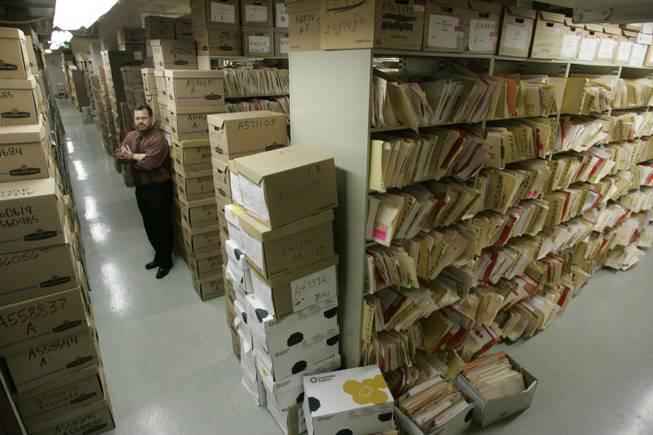
SAM MORRIS / LAS VEGAS SUN
District Court Assistant Administrator Steve Grierson stands amid boxes of files for cases from the past seven years at the Regional Justice Center. Eventually, they’ll be gone.
Tuesday, Feb. 17, 2009 | 2 a.m.
When Chief District Judge Art Ritchie first saw the overflowing case file room at the Regional Justice Center, it reminded him of the massive government warehouse at the end of “Raiders of the Lost Ark.”
In that scene, the long-sought Ark of the Covenant is stored among towering stacks of wooden crates lined up in rows as far as the eye can see.
In some ways, the Clark County judicial system’s way of operating has long seemed almost as antiquated as the ark itself. And the case file room takes up about half of the fourth floor at the courthouse, which officials estimate is about half the size of a football field. Tens of thousands of civil and criminal files are piled on metal shelves up to 10 feet high. Boxes of documents line the walls.
There is no more space for storage — which explains why the clerk’s office today is taking another step into the 21st century, no longer keeping paper documents in civil cases after they are scanned and processed electronically.
The move is part of a larger plan to make District Court more efficient and more accessible to the public. Next on the paperless route is expected to be criminal cases.
“The idea is to become a virtual court and take the distance out of access to justice,” said former court executive Chuck Short, who helped get $8.1 million from the County Commission in 2005 to develop a paperless case management system. The system being replaced was put in place in the 1980s and is not Internet friendly.
Court officials envision that with the new system people anywhere in the world should eventually be able to take care of their business with the court — file papers and even watch hearings — from a computer. If people prefer to go to the courthouse, they might one day be able to do business electronically similar to the way they check themselves out at grocery stores.
Eventually, officials said, all court documents will be filed electronically. At the moment, however, officials said, only about 11 percent of documents coming to the clerk’s office are filed without using any paper.
Officials don’t have a deadline for a switch to mandatory electronic filing, and they won’t commit to when they expect the court to go virtual. There have been some technical glitches over the past couple of years that have delayed the modernization efforts.
“We’re moving in that direction,” said Short’s successor, Ed Friedland. “We’re really evaluating what was done here in the past, and we will come out with a strategic plan.”
The new case management system has been rolled out in Family Court, which also has gone paperless.
“There’s a sense that things are running much more smoothly there,” said Assistant Court Administrator Steve Grierson, who oversees the clerk’s office.
Grierson said Family Court judges went through an “adjustment period” with the paperless system. Some are not totally comfortable with it yet. But today, instead of having to get clerks to haul paper files to their chambers, all the judges have to do is call up the cases on their computers and print out whatever documents they want. They also can access those cases from home computers.
Ritchie said the change allowed Family Court, which is not housed in the Regional Justice Center, to start converting its jam-packed case file room into badly needed additional hearing rooms for the growing number of judges.
District Court also will be able to make better use of its case file room, likely for new office space, Grierson said.
Tracking the steady flow of paper coming into the clerk’s office has not been easy.
In District Court last year, Grierson said, the clerk’s office received and scanned 4.1 million pages of civil and criminal documents. The office took in roughly 24,000 new civil cases.
Every day, Grierson noted, 72 clerks spend a total of 162.5 hours sorting and filing papers. It costs nearly $1 million and 42,250 employee hours a year to process all that paperwork.
Going paperless will let the clerk’s office “work smarter, rather than harder,” Grierson said. “It allows us to save money on services and supplies and prepares us to become more electronically savvy with our files.”
Last year, Grierson said, he asked the county for 12 to 15 new full-time positions to keep up with growth and all of the paperwork. No longer having to file court papers may eliminate the need to ask for that many positions in the future, he said.
Clerks now shuffling papers will be moved to imaging tasks and helping the public at the counter, especially during the peak afternoon rush hour, Grierson said.
The ultimate goal here, he explained, is to speed up the imaging process to significantly reduce the two-week lag time between when a document is filed and when it is available to the public.
After the new case management system comes on line by May, court officials hope to make documents available within a day after they’re filed.
In the end, the paperless system should wind up doing a lot more than just saving trees, officials said.

Join the Discussion:
Check this out for a full explanation of our conversion to the LiveFyre commenting system and instructions on how to sign up for an account.
Full comments policy